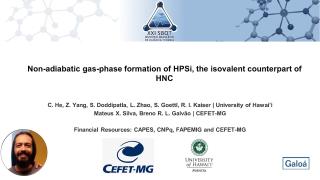Anais do Simpósio Brasileiro de Química Teórica
Proceedings of the XXI Brazilian Symposium on Theoretical Chemistry - Vol. 1 2021
Intermolecular Covalent Interactions: A Unified Framework for Pnictogen-, Chalcogen-, Halogen-, and Hydrogen Bonds
How to cite this paper?
To cite this paper use one of the standards below:
How to cite this paper?
- Presentation type: Apresentação Oral Assíncrona /Asynchronous Oral Communications
- Track: Density Functional Theory
- Keywords: Intermolecular Interactions; Bond theory; Density functional calculations;
Authors:
- 1 Department of Theoretical Chemistry / Amsterdam Institute for Molecular and Life Sciences / Vrije Universiteit Amsterdam
- 2 Universidade Federal de Lavras
- 3 Department of Theoretical Chemistry / Amsterdam Institute of Molecular and Life Sciences (AIMMS), Amsterdam Center for Multiscale Modeling (ACMM) / Vrije Universiteit Amsterdam
Intermolecular Covalent Interactions: A Unified Framework for Pnictogen-, Chalcogen-, Halogen-, and Hydrogen Bonds
Lucas de Azevedo Santos
Department of Theoretical Chemistry / Amsterdam Institute for Molecular and Life Sciences / Vrije Universiteit Amsterdam
Now you could share with me your questions, observations and congratulations
Create a topic- Presentation type: Apresentação Oral Assíncrona /Asynchronous Oral Communications
- Track: Density Functional Theory
- Keywords: Intermolecular Interactions; Bond theory; Density functional calculations;
Authors:
- 1 Department of Theoretical Chemistry / Amsterdam Institute for Molecular and Life Sciences / Vrije Universiteit Amsterdam
- 2 Universidade Federal de Lavras
- 3 Department of Theoretical Chemistry / Amsterdam Institute of Molecular and Life Sciences (AIMMS), Amsterdam Center for Multiscale Modeling (ACMM) / Vrije Universiteit Amsterdam
Intermolecular interactions are often referred to as non-covalent interactions. PnB, ChB, XB, and HB are significantly covalent in nature based on our quantitative KS-MO theory.
We challenge the commonly accepted, and purely electrostatic, sigma-hole model.
This model treats bond donors as a 2D surface with electrostatic potential.
Also, the bond acceptor is a point charge, which is far from the physical reality. "Non-Covalent Interaction" should be, thus, replaced by "Intermolecular Covalent Interaction".
Other analyzes
Sara Figueirêdo de Alcântara Morais
Hi Lucas, congratulations on your work and presentation! Did you perform other analyses, to further evaluate these non-covalent interactions, such as QTAIM or NCI analysis? Maybe AIM analysis may be particularly interesting to characterize the covalence of such interactions in your work.
- 1 like
- 1 answer
Comentário sobre o trabalho
Vinícius Bonatto
Oi Lucas, ótima apresentação e trabalho bem relevante! Tenho muito interesse neste tópico, pois muitas vezes, ao propor novos inibidores (candidatos a fármacos) uma maneira interessante de alcançar seletividade frente a outros alvos, é explorando estes tipos de interações (principalmente, halogênio e calcogênio). Porém, no meu caso, para simular estes tipos de interações ao analisar complexo inibidor-enzima por dinâmica molecular, utilizamos um ponto extra de carga positiva para representar o sigma-hole, até hoje, não tivemos problemas com essa aproximação. Gostei bastante do trabalho feito por vocês, bem interessante. Parabéns!
- 1 like
- 2 answers
Lucas de Azevedo Santos
Oi Vinícius, muito obrigado! De fato, para interações fracas e/ou a longas distâncias, o modelo sigma-hole acidentalmente funciona. Como ele exatamente trata as interações como se fossem entre cargas pontuais, essa abordagem para campos de força, ou incorporar a polarizabilidade em métodos semi-empíricos, também irá funcionar. Entretanto, imagino que haveriam problemas em lidar com interações "Anti-electrostatic" (angew. chem. int. ed. 2020, 59, 11150). Quem sabe modificações no Lennard-Jones potential ajudariam nesse sentido, né?
Vinícius Bonatto
Entendi Lucas, obrigado pelo comentário. Bem observado, para este caso poderiam haver problemas.
Streamline your Scholarly Event
With nearly 200,000 papers published, Galoá empowers scholars to share and discover cutting-edge research through our streamlined and accessible academic publishing platform.
Learn more about our products:
How to cite this proceedings?
This proceedings is identified by a DOI , for use in citations or bibliographic references. Attention: this is not a DOI for the paper and as such cannot be used in Lattes to identify a particular work.
Check the link "How to cite" in the paper's page, to see how to properly cite the paper



Lucas de Azevedo Santos
Hi Sara, thank you!
Our analyses are completely based on quantitative KS-MO theory in combination with canonical energy decomposition analysis. Then, we establish causal relationships between the phenomena we observe and physically meaningful terms. On the other hand, topological analyses of the electron density provide indicators used to trace empirical correlations, lacking a consistent understanding of good or bad correlations.
For instance, covalency, which comprises the electron-pair bonding or donor-acceptor orbital interactions, is well defined in our method by the relaxation of the anti symmetrized product wavefunction between two fragments. That is, how much is the orbital stabilizations due to the interaction between occupied and empty orbitals. The gradients of the electron density between chemical bonds do not necessarily translate these effects, especially for not considering orbital interactions. As such, it provides only a qualitative, instead of quantitative, picture of intermolecular interactions. In my opinion, it turns out to be unnecessary and just makes the argumentation weaker.